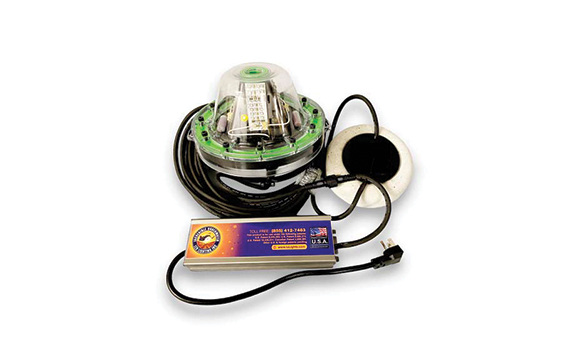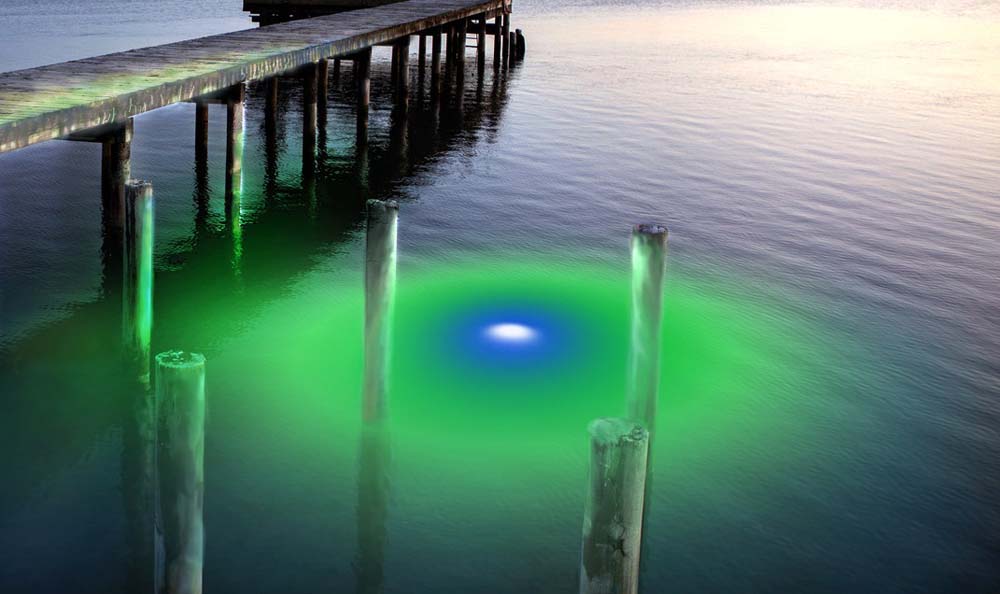Lighting technology below the waterline has come a long way. From early halogen setups prone to overheating, to compact, ultra-efficient LED systems that run for years without issue, the evolution of underwater marine lights is not just about aesthetics—it’s about performance, safety, and environmental responsibility.
At Incredible Underwater LED Lighting, we’ve seen—and helped shape—the transformation firsthand. Today’s lighting solutions do more than illuminate. They attract fish, improve dock safety, and bring entire waterfronts to life. In this article, we’ll explore how the technology has changed, why older systems are now obsolete, and how our patented lighting designs continue to raise the standard for what’s possible underwater.
The Early Days: Bulky Fixtures and High Heat
In the early days of underwater lighting, halogen and incandescent bulbs were the standard. These setups were power-hungry, generated intense heat, and required heavy-duty housings to protect against water intrusion. They weren’t designed with marine environments in mind—they were retrofitted, and it showed.
Maintenance was constant. Bulbs burned out quickly, often within a few months. Housings corroded. Installation required drilling into dock structures, and even then, water intrusion was a persistent threat. There were real safety risks too—overheated housings, exposed wires, and shorts that could occur in wet conditions.
These early systems were functional at best and hazardous at worst. Light output was uneven, energy consumption was high, and the appeal was limited to those willing to trade off safety and efficiency for novelty.
The Introduction of Low-Voltage Options

The move toward low-voltage systems marked a turning point. Designed to run on safer, more efficient power, these systems reduced risk and opened the door to longer runtimes without worrying about excessive power draw. Still, many early low-voltage systems lacked the brightness or durability to handle marine environments.
Manufacturers began experimenting with better seals, corrosion-resistant housings, and improved wiring. These upgrades helped, but the core problem remained: the light source itself wasn’t efficient enough. Heat build-up still occurred, and parts still wore out faster than they should have. The systems were safer, but they weren’t yet ideal.
Then came LED technology—and that changed everything.
The LED Breakthrough: Efficiency Meets Performance
The adoption of LEDs brought a level of reliability and control that traditional bulbs simply couldn’t match. LED stands for “light-emitting diode,” and these solid-state devices generate light with minimal heat. That meant lights could run longer without damaging nearby materials or requiring oversized cooling systems.
LEDs were also significantly more energy-efficient, converting more electricity into visible light and wasting less as heat. This not only extended bulb life but allowed for more compact housing designs and simplified installation. LEDs didn’t just make underwater lights better—they made entirely new applications possible.
At Incredible Underwater LED Lighting, we took this breakthrough and ran with it. Our patent-protected designs maximize the benefits of LED technology while eliminating the flaws that plagued older systems.
The Rise of Application-Specific Marine Lighting
LEDs didn’t just improve the core hardware—they enabled tailored lighting systems for specific uses. Whether you wanted to illuminate a dock walkway, attract fish, or create a glowing blue halo under your boat, LEDs could handle it—all while using less power and requiring less space.
This allowed marine lighting to become more than a safety add-on. It became a functional enhancement.
- Underwater dock lights started doubling as fish attractors.
- Boat owners could light hulls for both visibility and aesthetic effect.
- Marinas started using LED systems to enhance perimeter security without creating harsh glare or light pollution.
At every turn, LED systems proved superior. But not all LEDs are created equal.
What Makes Today’s Leading Systems Different
At a glance, many underwater lights look similar. But the performance difference comes down to engineering—both in the LED configuration and in the housing, wiring, and installation system.
In our case, we engineered every part of our system to work in tandem. That means:
- Low voltage, high-output LEDs that deliver consistent light without power spikes.
- Marine-grade housing that resists corrosion, impact, and long-term water exposure.
- Self-contained systems that require no drilling or external ballasts.
- Optimized wavelength output for specific purposes—especially attracting marine life.
And while competitors may offer cheaper alternatives, the difference shows up quickly: dimmer light, higher power draw, early failure, and more maintenance. That’s why we build for performance first, knowing that long-term value speaks for itself.
Why Patented Innovation Matters
One of the most important shifts in this industry has been the role of proprietary design. In an increasingly crowded market, many companies repackage the same basic product under different names. At Incredible Underwater LED Lighting, we don’t just source parts—we engineer our lights from the ground up and protect them with patents to ensure quality can’t be copied or compromised.
Our proprietary technology includes innovations in heat dissipation, LED clustering, and lens shape. These elements work together to produce a wide, even spread of light with optimal intensity—without overheating or dimming over time.
Environmental Considerations: Doing More With Less

As lighting technology improved, so did our understanding of its impact on marine life. Older systems leaked excess heat, generated light pollution, and even contained materials that could leach into the water over time. LED systems changed that.
All of our products are environmentally safe—built without toxic coatings or heavy metals. The low-voltage systems run cool, reducing disruption to water temperature and nearby habitats. And by using optimized wavelengths, like those in our green LED systems, we attract marine life without overwhelming the ecosystem.
It’s better for the environment. It’s better for fish populations. And it’s better for the people who want to enjoy the water without harming it.
The Road Ahead: Smarter, More Connected Systems
The next phase of underwater lighting will likely involve smart controls—timers, sensors, even remote monitoring. While the core technology is mature, control systems are just beginning to catch up. We’re already looking at ways to incorporate automation that aligns with natural feeding cycles and tide patterns, delivering even more effective fish attraction with less guesswork.
But no matter how smart systems get, one thing won’t change: quality still starts with fundamentals. If the light can’t survive underwater, can’t attract fish, or doesn’t save you money, all the connectivity in the world won’t matter.
That’s why we continue to innovate where it counts—performance, durability, and simplicity.
Illuminate the Future with Incredible Underwater LED Lighting
From heavy halogens to compact, high-output LEDs, the journey of underwater lighting has been one of constant improvement. But not all “modern” systems are equal. At Incredible Underwater LED Lighting, we’ve taken everything the industry has learned—and pushed it further.
With proprietary technology, marine-ready durability, and energy efficiency that makes sense, our lights don’t just meet today’s standards—they lead the way into the next generation of underwater lighting.
If you’re upgrading an old system, outfitting a new dock, or simply want to bring more life to the water, trust the team that understands both where lighting has been and where it’s going.
Contact us now for more information!


